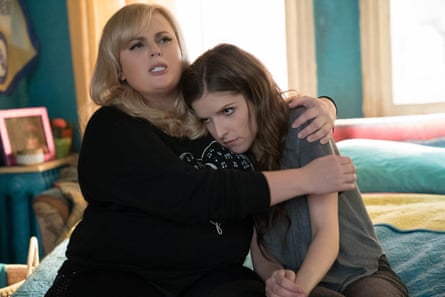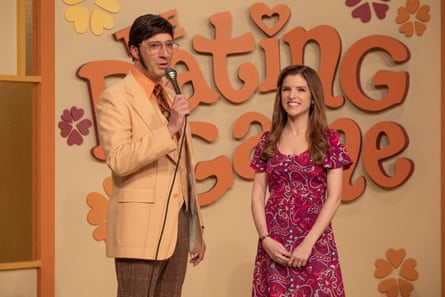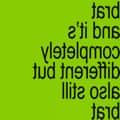This may be the year of the childless cat lady, but Anna Kendrick isn’t ready to team up with Taylor Swift just yet. “I don’t ever think about having kids, so I guess I spend just as little time thinking about weaponising that,” she says from the kitchen of her apartment in Los Angeles, hugging her grey cardigan close. One of the takeaways from the 39-year-old actor’s candidly funny 2016 book, Scrappy Little Nobody, in which she dished the dirt on the inherent weirdness of the film industry and her place in it, was: “Anna Kendrick in ‘Doesn’t Want Children’ Shock!” As she explained later, any child of hers would only end up being “another kid that your kid is going to have to fight when the water wars come”.
She sounds today like someone beyond even JD Vance’s comprehension: a woman who makes no apologies for wanting neither kids nor cats. “Here’s the best argument for why I don’t have kids,” she says, then explains how she was nodding off recently to the sound of TikTok cat videos. “I thought: ‘I’d have an easier time falling asleep with the weight of a cat on me. But I’m not responsible enough to own a cat. Someone should really make a robot cat that does all the purring and the kneading.’ And then I was like: wait, I’m not even up to the ‘cat lady’ part! Why would anyone trust me with a kid?”
Trust her with a movie and there will be no complaints. Having acted since childhood (she was nominated for a Tony award at 12), Kendrick found fame in the Pitch Perfect and Twilight series, and was Oscar-nominated for playing a corporate axe-wielder alongside George Clooney in Up in the Air. Now she has directed her first feature, Woman of the Hour, a factually inspired thriller about Rodney Alcala, the serial killer who appeared in 1978 on The Dating Game, the US forerunner to the UK’s Blind Date.

It was always the plan that Kendrick would co-produce the film as well as play Cheryl Bradshaw, the budding actor and Dating Game contestant who chose Alcala as her preferred bachelor. But, when the project, which had been in the works for two years, suddenly found itself with a start date and no director, Kendrick volunteered. She also came up with the film’s title. “There’s something perverse and ironic about Woman of the Hour,” she says. “This is supposedly Cheryl’s moment, but she’s an object of consumption and objectification.”
Although the film doesn’t stint on horror and suspense, especially in the agonising final sequence, it is devoid of the gloating quality typically found in serial killer narratives. That is partly because this isn’t really Alcala’s story, but rather a record of the bravery and even ingenuity of the women who fell into his orbit.
Kendrick was determined to treat each of them with dignity. “There was a moment where I was talking about a shot with the cinematographer and I realised that what he was pitching was very slick,” she recalls. “It would have been singled out by people and talked about. But I felt we couldn’t do that to the actress. I didn’t want to photograph anyone in a way that felt titillating.”
Many of the themes in the film follow on directly from those in her book, such as the pressure on women in the entertainment industry – and society at large – to be pliant and obedient to avoid being labelled difficult. These concerns were already woven into Ian McDonald’s script, but Kendrick has teased out a motif that might not have occurred to a man: the way women communicate the dangers and discomforts they face in the presence of men.
“The only note I had for the writer was: ‘You’re giving the women too much agency,’” she says. “Which sounds strange, because writers want to give their characters agency. They’re constantly being pushed to do just that. But there is a strange secret language between women. There are certain things I wouldn’t risk saying to a man if we were alone, such as: ‘Hey, you’re making me uncomfortable.’ It speaks really well of Ian that he wanted to give the women that agency, but I felt the more honest thing would be if they didn’t express exactly what was happening inside them.”
A case in point is the scene in which Cheryl is having drinks with Alcala in a bar and he presses her to stay for another round. “I rewrote that the night before shooting,” Kendrick says. “There used to be this moment where the waitress knocked over the drinks and Rodney got kind of aggressive. But suddenly it didn’t feel right.” Now, Cheryl finds an escape route by signalling subtly to the waitress, who lies on her behalf and says the bar is closing. “What is happening will be very clear to most women. And if it flies over some guy’s head, that’s not something I’m worried about.”
The parallels between the 1970s Hollywood shown in the film and the more recent past are impossible to miss, especially when Alcala admiringly namechecks Roman Polanski, who drugged and raped 13-year-old Samantha Geimer in 1977. “One scene that got cut showed some of Rodney’s co-workers chatting about the Polanski case,” says Kendrick. “We took it out, because it made it seem as if it was related to the killings. But people chatted about this stuff around the water cooler, as if it was a moral grey area, rather than a fucking crime.”
As recently as 2010, she says, the subject was still being discussed flippantly in Hollywood. “I remember being at parties and having to choose my words really carefully so as not to upset people when I pointed out that she was 13 and couldn’t possibly have consented. It’s easy to forget how casually people would be apologists for that stuff.”
Other traces of Kendrick’s experiences in the industry have found their way into Woman of the Hour. As a child actor, she was once ordered by a casting director to smile, because she didn’t seem very happy. (“I wasn’t so good at doing that ‘cheesy little kid’ thing,” she said in 2012.) In the film, Cheryl is put under exactly that pressure. There is also an audition scene in which she is asked whether she is willing to appear naked. “Ah, no,” says Cheryl. “Not for me.” The male casting director gestures at her breasts and says reassuringly: “Oh, I’m sure they’re fine.”
“That is lifted verbatim from something that happened to me when I was 19,” she says. As she starts to change the subject, her voice falters and she yanks her cardigan over her face. “Oh boy,” she says, fighting a sudden rush of emotion. She has already become briefly tearful several times during our conversation, but only in a joyous context, such as when expressing how proud and protective she feels towards Autumn Best, who is stunning as a teenage runaway who falls into Alcala’s clutches.
This is different. I ask if she is OK. “Yeah,” she says, laughing it off. “Yeah. I’ve, um … I’ve had experiences where I found out there was a wardrobe change that the costume designer had been cagey about, likely because she felt her hands were tied. It’s like you can’t get to the bottom of it: ‘Wait – sorry – um, why would I be in a bathing suit in this scene?’ But I’m grateful that this happens a lot less now. And when you say you’re uncomfortable, there’s more of a culture of being taken seriously.”

If Woman of the Hour represents a new maturity in Kendrick’s work, it hasn’t come out of the blue. When I ask whether the film is connected, as it seems to be, to Alice, Darling, the disquieting 2022 drama in which she played a woman in a coercive relationship, she nods emphatically. “Exactly right,” she says. “Everything else I was getting around that time I was just not connecting to. And suddenly there are these two really dark scripts with themes that feel very personal. I don’t think it was an accident that I responded to them.”
What she saw reflected in the script was her traumatic experience of being in a coercive relationship for five years. This made her more determined to honour its complexity on screen. At every point where the behaviour of Alice’s boyfriend could have been made explicit or unambiguous, Kendrick fought against it. She was even there in the editing room, asking the director, Mary Nighy, not to spell out what was happening, so that the audience would question Alice’s interpretation just as she doubts herself. After all, part of the insidious horror of a coercive relationship is its nebulous quality. For Alice, there are no bruises by which the abuse can be measured, only a constant low hum of dread.
Shortly after making Alice, Darling, Kendrick said that her body “still believes that [the abuse] was my fault” and explained that “recovery has been so challenging”. How does she feel now?
“I have good days and bad days,” she says. “But it’s more accurate to call them good months and bad months. If you’d asked me three years ago, I would have said there was something almost embarrassing about that. Like: ‘Aren’t you over it by now?’ But I guess I feel a lot grosser saying: ‘I’m doing great.’ If we speak in another five years, please God tell me I’m not still struggling then, you know? I don’t know how much of that feeling is based in my pure desire to feel OK versus: ‘That’ll mean I’m such a weakling.’ It’s all still swirling around in there somewhere.”
Her therapist has a phrase for it. “She says: ‘Grief has tentacles.’ Meaning that whenever there’s some minor challenging event in the present, it reaches back to more challenging things in the past. Sometimes I feel this specific event in my life is with me all the time and I wish I could just put it away.”
Source: theguardian.com





















